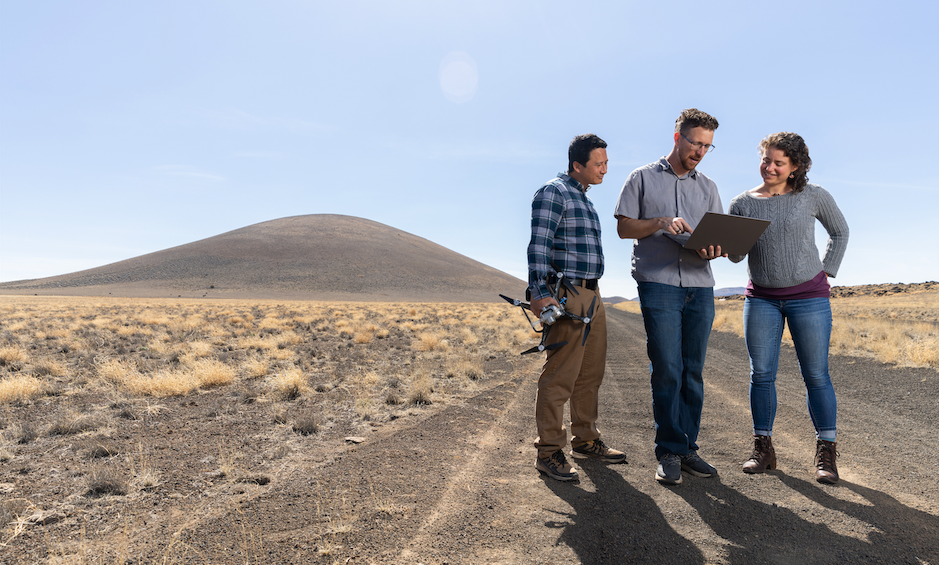Atmospheric dust plays a key role in Earth’s climate system. While it can have a positive impact, such as fertilizing the soilssoil, dust can also have a negative impact on our planet’s ecosystems, affecting everything from the weather to global warming.
For example, in the Four Corners region—which includes portions of Arizona, Colorado, Utah and New Mexico—millions of people rely on water that comes from snow in the San Juan Mountains that melts and eventually flows downstream into the Colorado River. Dust from the atmosphere falls on the snow, darkening it and accelerating snowmelt. As the snow melts more quickly, it evaporates faster, impacting water supplies in an area already affected by extreme drought.
Associate professor Nick McKay and his team of paleoclimatologists in NAU’s School of Earth and Sustainability have been studying dust for several years in this high-elevation region, which is particularly vulnerable to climate change. Funded through a private donation from Bob and Judi Braudy in 2016, they have collaborated with scientists at Cornell University to study the effects of dust and drought during Phase I of “The Drought-Dust Nexus in the Four Corners Region and Impacts on Society.” Now, with additional funding from the same donors, the collaborators will continue their research for five more years.
“It’s hard to overstate the impact of the Braudys’ gift,” McKay said. “It gave us the freedom to pursue some high-risk, cutting-edge science that would have been difficult to support with traditional mechanisms, while supporting three graduate students and several more undergraduate students. It helped launch a new generation of scientists here at NAU. Toby and I were delighted that the Braudys were interested in funding more research in a new and exciting direction.”
The Cornell team is led by associate professor and climate scientist Toby Ault and includes research associate Carlos Carrillo. In addition to principal investigator (PI) McKay, the NAU team includes assistant research professor Cody Routson, Stephanie Arcusa—who led NAU’s effort on Phase I of the project, completed her Ph.D. in December 2020 and is now a postdoctoral research fellow at Arizona State University—and Ph.D. student Frank Telles, who joined McKay’s team for Phase II. Telles is an Indigenous student from the Chiricahua Apache Nation of New Mexico. Along with his passion for climate science, Telles is committed to doing research that will ultimately help Indigenous peoples in the region, including the Navajo, Hopi, Ute and Zuni tribes.

At NAU, McKay and Arcusa developed new paleoclimate records of dust deposition over the past 15,000 years using lake sediment and compared them to records of drought from tree rings and other natural archives.
“The big surprise from Steph’s work in Phase I is that the natural relationship between dust and drought is much more subtle than we had assumed,” McKay said.
“From the lake records we see the Southwest is dustier today than in the past 11,000 years with peak dustiness in the mid-1800s, but this is uncorrelated with the drought records,” Arcusa said.
The NAU team published its early findings in the peer-reviewed journal The Holocene, where they noted, “our results demonstrate that although the Colorado Plateau is naturally prone to dustiness, drought is a secondary driver of dust accumulation in the mountains. This suggests that land-use management decisions aimed at reducing land disturbance can mitigate future dust accumulation, despite projected increases in regional aridity.”
The scientists found that the accumulation of dust has been heavily influenced by the presence of disruptive human activity and land use such as cattle grazing, which, the team hypothesizes, makes dust emissions more sensitive to droughts.
The team used their unanswered questions from the first phase to develop research goals for the second phase, during which they will deploy uncrewed aircraft being designed at Cornell to chase dust storms in the atmosphere over northeastern Arizona and the Four Corners region and collect dust samples and data for research. They will also use weather balloons equipped with low-cost sensors to track the flow of dust from the land surface into the atmosphere.
McKay and his team, all part of his Paleoclimate Dynamics Laboratory, use natural records of past climate variability to inform our understanding of climate dynamics. They study natural climate variability in places ranging from the tropics to the Arctic, on timescales ranging from years to millennia and on spatial scales ranging from hemispheres to meters.
“A lot of my research is at very large spatial scales, so I love getting to work locally and to address issues that affect northern Arizona directly,” McKay said. “Dust has many impacts on society, impacting human health and safety, snowpack and water resources, agriculture and the tourism industry, yet we still have a lot to learn about how climate affects dust, how dust moves through the atmosphere and how to predict when and where dust storms will occur.”
Kerry Bennett | University Marketing




